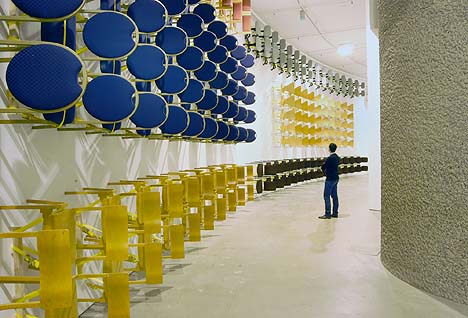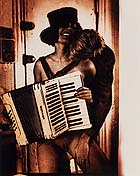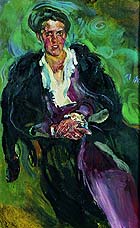
translated and summarized by: Liz Wollner-Grandville,
English summary May 19-25
Barbican Art Gallery: Hans Schabus – Next Time I’m Here, I’ll Be There
Space Odyssey
Digging was out of the question and so was flooding. And sand – no, one couldn’t repeat that again; sand was just used recently, in Santa Fe. Hans Schabus was in a tight spot. But then Schabus struck on an idea how he could distinctively change the space of this utopian London landmark, the Barbican, without going to the extremes, to which he usually goes. All he had to do was tilt the gallery. He was inspired by the fact that the length of “The Curve”, as the Barbican Art Gallery is called, mirrors that of a Boeing 747, and installed 461 chairs, sourced exclusively from the Barbican Centre.
Entering “The Curve” immediately reminds of Stanley Kubrick’s “Odyssey 2001” and the huge rotating Ferris wheel, which completely discombobulates spatial perception and seems to turn the world upside down. This association is reinforced by the fact that the Barbican, this huge cultural centre regularly chosen as London’s ugliest building, resembles a spacecraft, which landed in the middle of London.
Similar to Kubrick’s “Discovery” Schabus’ installation makes us believe we are part of an adventurous journey. The chairs, which have been ordered strictly according to their colour and form and were taken from all different parts of the Barbican (cafés, offices, event locations), inspire an imaginary tour of the entire building. This constellation mirrors the atmosphere in an airplane, where an occupant is practically immobilized and controlled by strangers.
To complement this installation, Schabus lets microphones take up the sounds made within the entire building and streams them into the gallery through a series of speakers. This additional effect not only underlines the metaphor of the airplane sound, but also transports tone into a space, which – upon reflecting the original function of this room – would normally never be here.
Simply complex – but successful.
Barbican Art Gallery
EC2Y 8DS London, Barbican Centre, Silk Street, until 01. 06. 2008
www.barbican.org.uk
Kunsthalle Wien: Punk – No One is Innocent
Creative craters
Punk at a museum - this is definitely one of the loudest performative contradictions offered within the cultural purview. At least at first sight, when destruction is faced with conservation, the proletariat with the bourgeoisie, and garbage with culture.
The catalogue of the exhibit begins with a quote by the anarchist Michail Bakunin on the creative power of destruction. This exhibit in the Kunsthalle, however, presents the opposite: the destructive power of creativity. The curator of the exhibit Thomas Mießgang, mainly refers to one of Pop theoretician Greil Marcus’ theses: that there was a connection between the artistic avant-garde and punk. The show not only focuses on the beginnings in the late 1970s in London, Berlin (West) and New York, but also on the first two terms of the punk exhibit subtitle “Art – Style – Revolt”.
Jon Savage, the eloquent chronicler of this movement, contributed a series of black and white Pentax photographies. They depict those today already gentrified city-centre “craters” (Savage), in and out of which punk had developed. This was the starting point from which subculture and the art scene, fashion and music all flowed into one another. Inevitably one of the pieces exhibited is the “Stahlschlagzeug, ca. 1980” (steel percussions, around 1980) of the Berlin-based band “Einstürzende Neubauten” (collapsing new buildings). One does need group objects to visualize group rituals. And anyhow – no one is innocent.
Kunsthalle Wien
1070 Vienna, Museumsplatz 1, until 07.09.2008
www.kunsthallewien.at
Museum des Nötscher Kreises: 10th Anniversary
Light reflections
Late, but not too late, the “Museum des Nötscher Kreises” was opened on May 16, 1998 in Franz Wiegele's birth house. The museum has become an important cultural venue presenting the life and work of the members of the Nötscher Kreis (Nötscher Circle), which was made up of group of artists, who were either born in the Carinthian Gailtal such as Sebastian Isepp (1884 – 1954) and Franz Wiegele (1887 – 1944) or who moved to Nötsch like Anton Kolig (1886 – 1950) and Anton Mahringer (1902 – 1974).
The small town of Nötsch was the most important sphere of life and work for these renowned Expressionists, despite their numerous voyages abroad. This was the main reason to open the museum in this little town. The museum should, however, present itself a little more self-assured: after all, many large exhibitions throughout Austria obtained their pieces from here.
On the occasion of its tenth anniversary the museum is displaying well-known works by the four artists as well as pieces, which had never been exhibited here before. One thing all of these paintings have in common is that they were all created in Nötsch. In addition, the paintings of all four artists convey a special, intense and mutual direction of light. The reason may lie in situ: even the inexperienced will discover the unique softness of the summer twilight special to this region of the Carinthian Gailtal, and it is something one seems to rediscover in all of these paintings.
Museum des Nötscher Kreises
9611 Nötsch im Gailtal, Haus Wiegele im Gailtal 39, until 01.06.08
www.noetscherkreis.at
Albertina: Oskar Kokoschka – Exile and New Home 1934 – 1980
Exile and new home
Lets not even think about what would have happened if this man had not lived to be 94. If he would not have been chased through the most inhumane (twentieth) century, and if he wouldn’t have experienced all of the chicanes of displacement and odyssey and if he wouldn’t have had to fear for his life. If he would have not left an oeuvre which uncovered the questions of humankind ranging between uproar and opportunism, narcissism and gestures of greatness. Two Viennese institutions would have not been able to share the same topic.
But everything turned out to be all right. After the Belvedere had shown Oskar Kokoschka’s early works, the Albertina is now exhibiting his later works. Still, they both missed out on 12 years of his oeuvre: there is nothing to be seen of the work he had completed between 1922 and 1934. Maybe a third museum in Vienna could…?
In “Exile and New Home” one can follow Kokoschka’s defection to Czechoslovakia, how he barely made it to England, his involvement with the allies during World War II, his transition to a cosmopolite and then again his suburbanisation, even if only for the sake of the summer academies in Salzburg. As a sceptic and acquainted with the abysms of friendliness, he, like Thomas Mann, preferred to live in Switzerland.
Kokoschka paints great stories – dealing with cities, antique mythology or Shakespeare. His knowledge vanquished the boisterousness of his youth. Nevertheless, his style remains full of rhetoric; he still hangs in there. Despite all serenity he has not taken a silent path – maybe this makes him so attractive to such exalted painters as Maria Lassnig or Georg Baselitz. But Kokoschka has something the others lack - irony. “Time, Gentlemen, please” is the title of one of his last paintings. This notorious closing remark in a pub was aimed at himself, as a bouncer out of his own long life.
Albertina
1010 Vienna, Albertinaplatz 1, until 13. 07. 2008
www.albertina.at
Mehr Texte von translated and summarized by: Liz Wollner-Grandville


 Teilen
Teilen




